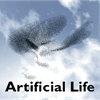爬行蜈蚣类虚拟生物的行为多样性。
IF 1.5
4区 计算机科学
Q4 COMPUTER SCIENCE, ARTIFICIAL INTELLIGENCE
引用次数: 0
摘要
机器人控制器通常针对单一环境中的单个机器人进行优化。这种方法被证明是脆弱的,因为这样的控制器通常无法为新的形态或环境产生合理的行为。相比之下,动物的步态稳健而灵活。通过观察动物,并试图从它们的运动中提取运动的一般原理,我们的目标是设计一个单一的,分散的控制器,适用于不同的形态和环境。控制器实现了(a)波动,(b)蠕动和(c)腿部运动的三个组成部分,我们认为这是大多数动物步态的基本要素。这项工作是迈向通用控制器的第一步。因此,该控制器已在有限范围的模拟蜈蚣机器人形态上进行了评估。蜈蚣之所以被选为灵感,是因为它的运动同时使用身体收缩和腿部运动。为了使控制器能够在不同的设置中工作,它也必须能够表现出不同的行为。我们发现六种不同的运动模式出现从我们的控制器响应环境和形态的变化。我们还发现蜈蚣模型的不同部位可以同时表现出不同的运动模式,这是基于局部形态特征的。通过快速测试形态的潜力,该控制器可以潜在地帮助机器人的设计或进化,或者用于深入了解蜈蚣的潜在运动原理。本文章由计算机程序翻译,如有差异,请以英文原文为准。
Behaviour Diversity in a Walking and Climbing Centipede-Like Virtual Creature
Robot controllers are often optimized for a single robot in a single environment. This approach proves brittle, as such a controller will often fail to produce sensible behavior for a new morphology or environment. In comparison, animal gaits are robust and versatile. By observing animals, and attempting to extract general principles of locomotion from their movement, we aim to design a single, decentralized controller applicable to diverse morphologies and environments. The controller implements the three components of (a) undulation, (b) peristalsis, and (c) leg motion, which we believe are the essential elements in most animal gaits. This work is a first step toward a general controller. Accordingly, the controller has been evaluated on a limited range of simulated centipede-like robot morphologies. The centipede is chosen as inspiration because it moves using both body contractions and legged locomotion. For a controller to work in qualitatively different settings, it must also be able to exhibit qualitatively different behaviors. We find that six different modes of locomotion emerge from our controller in response to environmental and morphological changes. We also find that different parts of the centipede model can exhibit different modes of locomotion, simultaneously, based on local morphological features. This controller can potentially aid in the design or evolution of robots, by quickly testing the potential of a morphology, or be used to get insights about underlying locomotion principles in the centipede.
求助全文
通过发布文献求助,成功后即可免费获取论文全文。
去求助
来源期刊

Artificial Life
工程技术-计算机:理论方法
CiteScore
4.70
自引率
7.70%
发文量
38
审稿时长
>12 weeks
期刊介绍:
Artificial Life, launched in the fall of 1993, has become the unifying forum for the exchange of scientific information on the study of artificial systems that exhibit the behavioral characteristics of natural living systems, through the synthesis or simulation using computational (software), robotic (hardware), and/or physicochemical (wetware) means. Each issue features cutting-edge research on artificial life that advances the state-of-the-art of our knowledge about various aspects of living systems such as:
Artificial chemistry and the origins of life
Self-assembly, growth, and development
Self-replication and self-repair
Systems and synthetic biology
Perception, cognition, and behavior
Embodiment and enactivism
Collective behaviors of swarms
Evolutionary and ecological dynamics
Open-endedness and creativity
Social organization and cultural evolution
Societal and technological implications
Philosophy and aesthetics
Applications to biology, medicine, business, education, or entertainment.
 求助内容:
求助内容: 应助结果提醒方式:
应助结果提醒方式:


